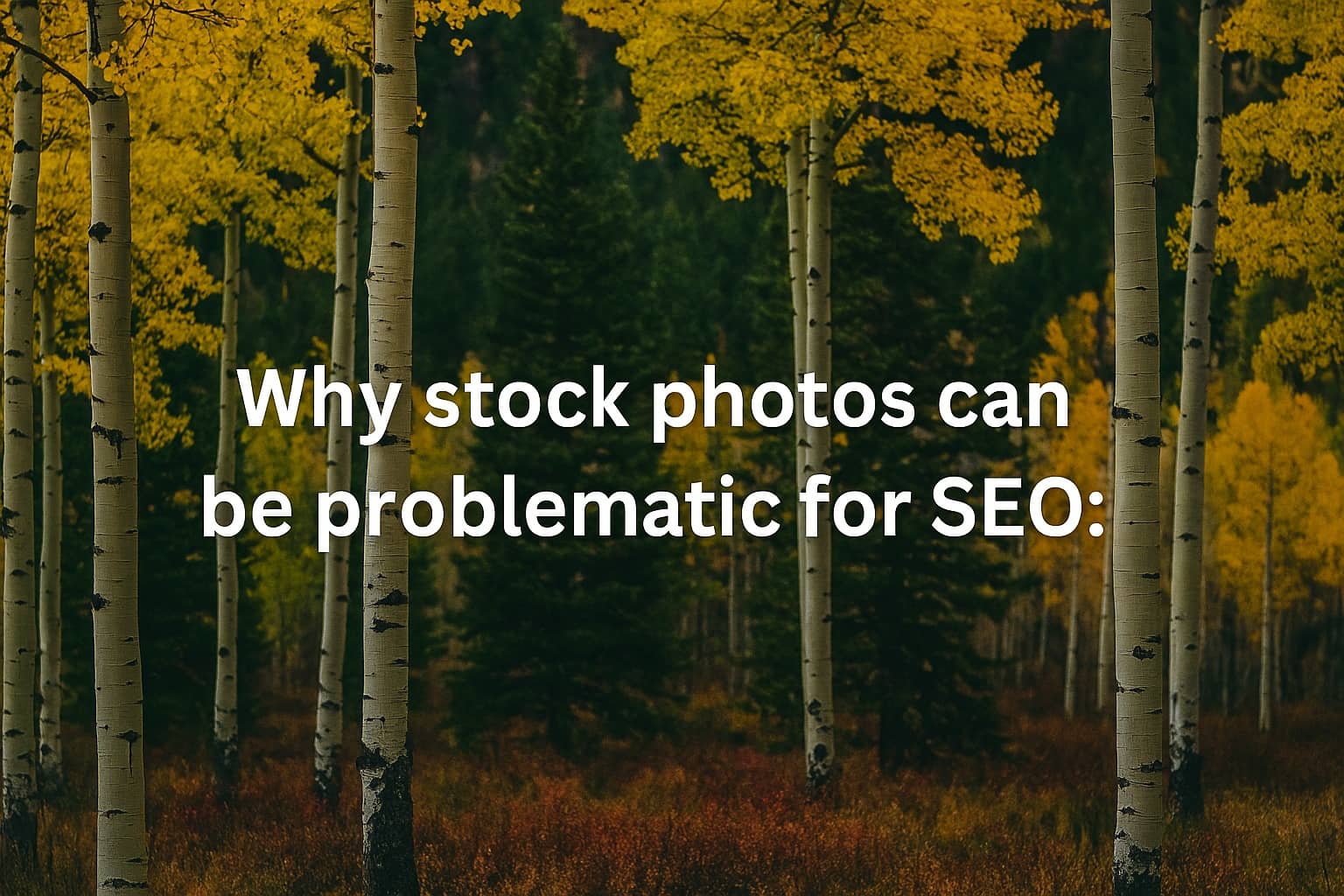table of contents
In the world of digital marketing, visuals carry weight—and not just with your audience. Search engines are paying closer attention to the images you use, and stock photos can quietly work against your SEO efforts. While they’re convenient, they often signal low authenticity and generic content, which can erode user trust and reduce your site’s credibility.
For Colorado businesses trying to stand out in competitive local markets, this matters. Search engines interpret reused or irrelevant visuals as poor content quality. That can lead to higher bounce rates, shorter time-on-page, and lower rankings. Visitors disengage when images feel disconnected or cliché, and that disengagement sends signals that your site lacks expertise or originality.
Original content, including unique, locally relevant images, helps reinforce your authority and improve SEO performance. Whether it’s a snapshot of your team on a job site in Fort Collins or a branded visual featuring Colorado’s golden aspens, authenticity matters.
Let’s explore how your visual strategy can support stronger search rankings, and why it’s time to rethink the role of stock photography.

Stock Photos SEO
Just like a real Colorado aspen grove thrives on diversity and rooted connection, your SEO suffers when you replace authentic visual content with stock images that feel cloned and disconnected.
Potential for poor user experience
When users land on a webpage, stock photos can quickly signal a lack of authenticity and erode trust. These generic visuals immediately communicate a disconnected, impersonal experience that feels manufactured rather than genuine. In contrast, original or custom visuals are more likely to engage visitors and enhance visual appeal, making your content stand out and encouraging deeper interaction.
You’ll notice visitors are likely to disengage when confronted with overused imagery that doesn’t reflect real brand context or specific content details. The psychological impact is immediate: users perceive your website as less credible, less invested, and potentially less professional. Original images help reinforce brand identity and foster trust, making your site more memorable and credible in the eyes of your audience. This perception translates directly into higher bounce rates, reduced time-on-page, and diminished user engagement—critical metrics that search engines interpret as signals of poor user experience.
Limited ability to support E-E-A-T (Experience, Expertise, Authoritativeness, Trustworthiness)
While stock photos might fill visual space, they fundamentally undermine Google’s E-E-A-T signals by failing to authentically represent your brand’s unique expertise and experience. Generic images dilute your professional narrative, creating distance between your actual capabilities and audience perception. Original images featuring your team, work environment, or project outcomes demonstrate tangible evidence of your expertise. Hiring a professional photographer or creating custom visuals can further strengthen brand representation and support E-E-A-T by providing high-quality, authentic visuals that reflect your company’s identity. They communicate real-world experience, showing potential clients you’re not just another anonymous service provider. By showcasing genuine moments and professional contexts, you’ll build credibility that stock imagery can never replicate, as custom visuals provide a more authentic brand representation than stock imagery, directly supporting your website’s trustworthiness and authority.
May not be relevant or high-quality
Stock photos represent a double-edged sword in digital content strategy, particularly when their relevance and quality fall short of audience expectations. Stock photos are often used across various websites, which can lead to the same image appearing on multiple websites and reducing your brand’s uniqueness. Misaligned or generic visuals can instantly signal inauthenticity, causing users to disengage from your content. Your audience craves genuine, contextually precise imagery that directly reflects the narrative or service you’re presenting. Low-resolution, cliché, or irrelevant stock photos not only diminish user trust but also communicate a lack of professional investment. There are also duplicate content concerns when the same image is used on multiple websites, as this can negatively impact SEO by confusing search engines and undermining your site’s authority. Search engines increasingly prioritize visual content that demonstrates clear topical relevance, making high-quality, purposeful imagery essential for maintaining SEO performance and user engagement.
When they are properly optimized
Strategic image optimization converts mundane stock photos from potential SEO liabilities into powerful digital assets. By implementing key techniques, you can alter generic visuals into search-friendly content. Optimizing images, including compressing images and using descriptive file names, is essential for SEO.
- Compress images and optimize images to reduce file size and improve page load speeds
- Craft descriptive, keyword-rich alt text and use descriptive file names that help search engines understand image content
- Rename image files with specific, relevant file names aligned to content
Properly optimized stock photos improve accessibility, provide visual context, and signal relevance to search algorithms. Optimizing images with descriptive file names and alt text helps search engines understand your content and improves SEO. The goal is to alter standard imagery into strategic SEO tools that boost engagement, reduce bounce rates, and improve overall page performance.
When they are used strategically
When professional content creators lack immediate access to custom imagery, strategically selected stock photos can effectively bridge visual communication gaps. Careful image selection, including the use of custom images, can significantly improve the SEO of web pages by enhancing relevance, originality, and user engagement. By carefully choosing relevant, high-quality stock images that align with content themes, you can improve page aesthetics and user engagement.
|
Strategy
|
Benefit | Impact |
|---|---|---|
| Relevant Matching | Content Alignment | Higher User Retention |
| Unique Editing | Brand Personalization | Increased Visual Interest |
| Keyword Optimization | SEO Improvement | Improved Search Rankings |
| Compression Techniques | Faster Load Times | Better Page Performance |
| Image Selection & Custom Images | Optimized Web Page Performance | Enhanced SEO and Authenticity |
Thoughtful stock photo selection converts generic visuals into powerful communication tools, supporting your content’s narrative and SEO objectives across web pages.
Benefits of Using Stock Photos
While budget constraints and time limitations often challenge content creators, professional stock photos offer a pragmatic solution for visual communication. They provide immediate benefits when used strategically:
- Deliver high-resolution, visually appealing imagery instantly
- Reduce production costs compared to custom photography
- Support rapid content development for lean marketing teams
Stock photo sites offer a wide range of images that can be used across multiple platforms, including social media posts and blog posts, supporting a cohesive digital marketing strategy.
Stock photos can improve your digital presence when carefully selected and optimized. Their professional quality fills visual gaps, enabling faster content creation without sacrificing aesthetic standards. By choosing contextually relevant images and implementing proper SEO techniques like descriptive alt text and strategic file naming, you’ll maximize their potential while maintaining a polished, professional digital appearance.
Risks and Limitations
While stock photos offer quick visual solutions, they come with serious drawbacks that can undermine your digital marketing efforts. Generic visuals lack originality and can signal to search engines that your content isn’t unique, weakening your SEO. They also disconnect your brand from authentic representation, reducing user trust and engagement. A/B tests consistently show that original images outperform stock photos in conversion rates. Worse, misusing licensed images—especially those pulled from other websites—can expose you to copyright penalties and legal risks. Search engines now prioritize distinctive, contextually relevant visuals, so relying on stock photos can actively harm your rankings and dilute your brand’s credibility.
Stock Photos Can Hurt Your SEO
Generic visuals signal low-value content, reduce engagement, and make your site less distinctive; ultimately your hurting rankings and conversions.
Copyright & Credibility Risks
Using unlicensed images can trigger legal issues and erode user trust. Authentic visuals build credibility and protect your brand’s reputation.
SEO Best Practices for Images
Recognizing the potential pitfalls of stock photography doesn’t mean abandoning visual strategies, it means optimizing them strategically. When using images for SEO, you’ll want to focus on:
- Rename files descriptively with target keywords
- Write detailed alt text that improves accessibility
- Compress images to enhance page loading speed
Optimizing images with relevant keywords and descriptive file names helps search engines understand image content, improving visibility in google images, google image search, and image search results.
Effective search engine optimization and a strong SEO strategy for images can improve your website’s SEO, drive more organic traffic and website traffic, and enhance quality content.
Your visual content can still drive engagement when approached analytically. By altering generic stock photos into strategic SEO assets, you’ll signal relevance to search algorithms while maintaining visual appeal. Optimizing images can improve search results visibility, support local search results, and benefit blog posts and blog content targeting specific target keywords. The key is intentional optimization—turning potential limitations into opportunities for better search visibility and user experience.
Ongoing SEO efforts focused on image optimization are essential for maximizing search engine performance and overall website success.




